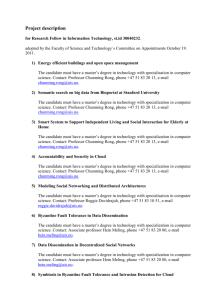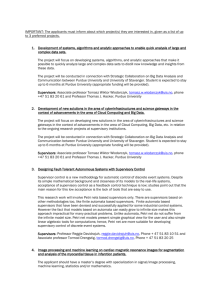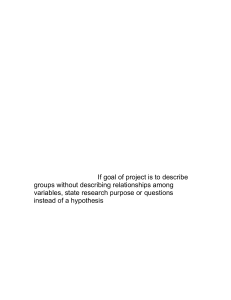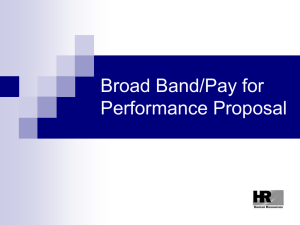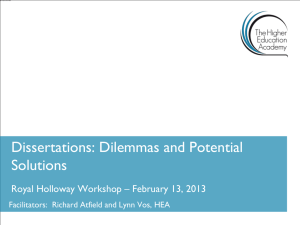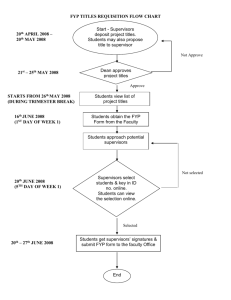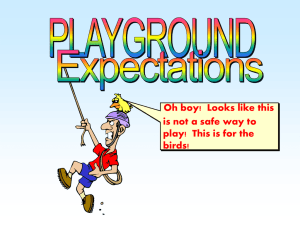Project 1: Title: Video monitoring of newborns in low resource
advertisement
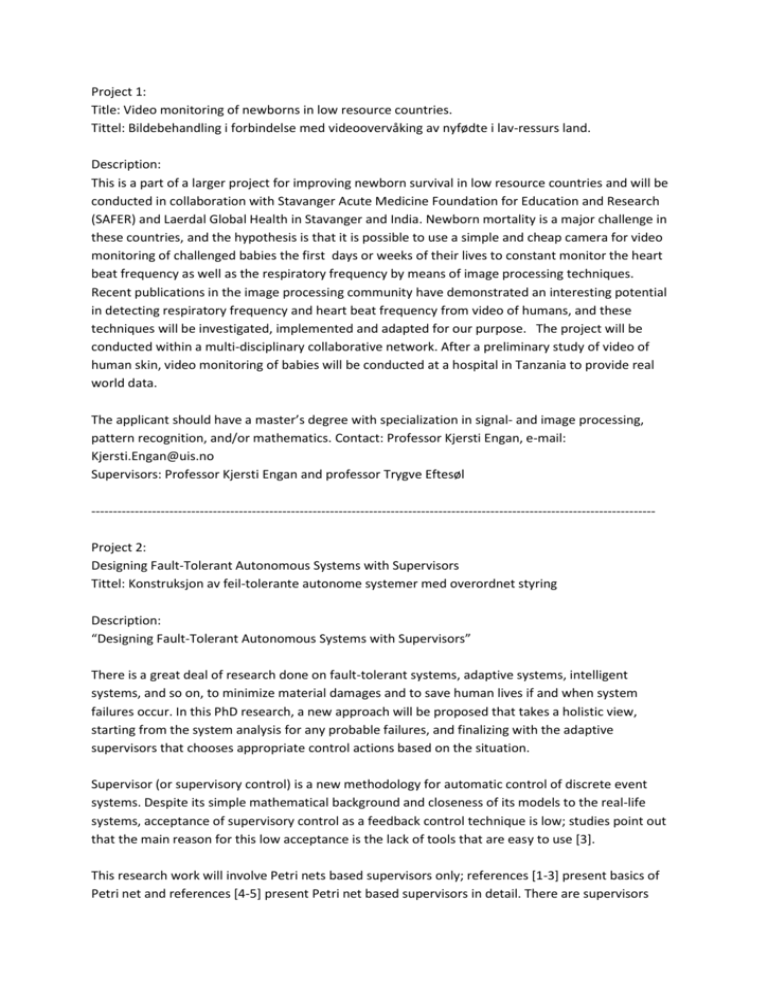
Project 1: Title: Video monitoring of newborns in low resource countries. Tittel: Bildebehandling i forbindelse med videoovervåking av nyfødte i lav-ressurs land. Description: This is a part of a larger project for improving newborn survival in low resource countries and will be conducted in collaboration with Stavanger Acute Medicine Foundation for Education and Research (SAFER) and Laerdal Global Health in Stavanger and India. Newborn mortality is a major challenge in these countries, and the hypothesis is that it is possible to use a simple and cheap camera for video monitoring of challenged babies the first days or weeks of their lives to constant monitor the heart beat frequency as well as the respiratory frequency by means of image processing techniques. Recent publications in the image processing community have demonstrated an interesting potential in detecting respiratory frequency and heart beat frequency from video of humans, and these techniques will be investigated, implemented and adapted for our purpose. The project will be conducted within a multi-disciplinary collaborative network. After a preliminary study of video of human skin, video monitoring of babies will be conducted at a hospital in Tanzania to provide real world data. The applicant should have a master’s degree with specialization in signal- and image processing, pattern recognition, and/or mathematics. Contact: Professor Kjersti Engan, e-mail: Kjersti.Engan@uis.no Supervisors: Professor Kjersti Engan and professor Trygve Eftesøl ---------------------------------------------------------------------------------------------------------------------------------Project 2: Designing Fault-Tolerant Autonomous Systems with Supervisors Tittel: Konstruksjon av feil-tolerante autonome systemer med overordnet styring Description: “Designing Fault-Tolerant Autonomous Systems with Supervisors” There is a great deal of research done on fault-tolerant systems, adaptive systems, intelligent systems, and so on, to minimize material damages and to save human lives if and when system failures occur. In this PhD research, a new approach will be proposed that takes a holistic view, starting from the system analysis for any probable failures, and finalizing with the adaptive supervisors that chooses appropriate control actions based on the situation. Supervisor (or supervisory control) is a new methodology for automatic control of discrete event systems. Despite its simple mathematical background and closeness of its models to the real-life systems, acceptance of supervisory control as a feedback control technique is low; studies point out that the main reason for this low acceptance is the lack of tools that are easy to use [3]. This research work will involve Petri nets based supervisors only; references [1-3] present basics of Petri net and references [4-5] present Petri net based supervisors in detail. There are supervisors based on other methodologies too, like finite automata based supervisors. Finite automata based supervisors that have been devised and successfully applied for some industrial control systems [67]. However the fact that models based on automata can easily grow to infinite size makes this approach impractical for many practical problems [5]. Unlike automata, Petri net do not suffer from the infinite model size. Petri net models present simple graphical view for the user and also simple linear algebraic tools for computations; hence, Petri net are more suitable for developing supervisory control of discrete event systems [5]. REFERENCES 1. T. Murata. “Petri Nets: Properties, Analysis, and Applications”. Proceedings of the IEEE, 77 (4), pp. 541-580, 1989 2. M. Silva, E. Teruel, and J. M. Colom. “Linear Algebraic Techniques for the Analysis of P/T Net Systems”. In Lectures in Petri Nets I: Basic Models. Springer, 1998 3. J. M. Colom. “Some suggestions for future research”. L20 – Lecture notes for the PhD course on Petri nets, UPC, Barcelona, 14-25 May 2012 4. M. V. Iordache and P. J. Antsaklis. Supervisory control of concurrent systems: a Petri net structural approach. Boston: Birkhauser, 2006 5. J. O. Moody and P. J. Antsaklis. Supervisory Control of Discrete Event Systems Using Petri Nets. Springer verlag, 1998 6. P. Ramadge and W. Wonham. “The control of discrete event systems. In Discrete event dynamic systems”, Proceedings of the IEEE. v77 i1. 81-98, 1989 7. W. Wonham and P. Ramadge. “On the supermal controllable sublanguage of a given language”, SIAM Journal on Control and Optimization, v.25 n.3, p.637-659, May 1, 1987 Veiledere: Reggie Davidrajuh og Tormod Drengstig - KONTAKTINFO ------------------------------------------------------------------------------------------------------------------------------------------- Project 3: Semantic Entity Search / Semantisk Entity Søk Semantic search refers to the idea that the search engine understands the concepts, meaning and intent behind the query that the user enters into the search box, and provides rich and focused responses (as opposed to merely a list of documents). Entities, such as people, organizations or products, play a central role in this context; they reflect the way humans think and organize information. We can observe that major search engines (like Google or Apple's SIRI) are becoming "smarter" day by day in recognizing specific types of objects (for example, locations, events or celebrities); yet, true semantic search has still a long way to go. This project aims to develop a theoretically sound and computationally efficient framework for entity-oriented information access: the search and discovery of entities and relationships between entities. A key element to a successful approach is the combination of massive volumes of structured and unstructured information from the Document Web and the Data Web, respectively. Successful candidates will be expected to conduct research, design, develop, and deploy state-of-art, scalable information retrieval, information extraction and machine learning techniques for innovative entity-oriented search applications. The project will include both theoretical and empirical explorations, where lab-based results will be evaluated in 'live' environments with real users. Qualifications: M.Sc. in Computer Science, Computational Linguistics, Mathematics or related fields by the appointment date. Good written and spoken command of English. Research experience or a track record of project based work, demonstrable interest in the domain, solid programming skills (particularly Java), and experience in manipulating and analyzing large data sets (esp. using Hadoop) are a clear plus. Supervisor: Associate professor Krisztian Balog ----------------------------------------------------------------------------------------------------------------------------- Project 4: Intelligent real-time industrial operations using Big-data Analytics (Intelligent sant-tid industrielle operasjoner ved å bruke Big-data analytikk): The project aims to research and develop a new monitoring control system that in real-time guarantee a risk reduction to zero tolerance in industrial operations (e.g. in oil and gas, smart grids). The new monitoring system will combine several methods from different knowledge domains into a unique robust platform that can monitor complex life-critical systems guaranteeing zero tolerance for errors. The main domains to be combined are Ontology/semantics, Model Checking, Adaptive Control, Artificial Intelligence and Big Data analysis. Supervisors: Professor Chunming Rong (chunming.rong@uis.no) Co-supervisor: Rui Esteves ----------------------------------------------------------------------------------------------------------------------------------- Project 5: Smart Cities using Big-data Analytics (Smart by anvendelser ved å bruke Big-data analytikk): Big data describes datasets whose volume, velocity, variety and complexity exceed ability of commonly used software tools to capture, process, store, manage, and analyse them. It requires efficient analytics methods in a world where data availability is exploding. We shall explore the potential applications in relation to making the daily life of citizens easier. Supervisors: Professor Chunming Rong chunming.rong@uis.no Co-supervisor: Mohsen Assadi / Erdal Cayirci ----------------------------------------------------------------------------------------------------------------------------------Project 6: Security, and Privacy in Big-data and Cloud Services (Sikkerhet, personvern i big-data og tjenester i nettsky): Accountable organizations ensure that obligations to protect data are observed by all who process the data, irrespective of where that processing occurs. We need accountability in the cloud because there is a higher risk to privacy and security that is a magnification of issues faced in subcontracting and offshoring, with some new threats and with the cloud’s dynamism rendering inappropriate most traditional mechanisms for establishing trust and regulatory control. Supervisors: Professor Chunming Rong (chunming.rong@uis.no) Co-supervisor: Erdal Cayirci / Janne Hagen -------------------------------------------------------------------------------------------------------------------------------------Project 7: Software Defined Networking (SDN) and Network Virtualization (Software definerte nettverk (SDN) og nettverk virtualisering): Software Defined Networking (SDN) and Network Virtualization are trending research topics in computer science and networking disciplines. In SDN capable networks, the control plane is separated from the forwarding plane and a single control plane can control several forwarding planes. This approach yields to more control and better fault tolerance in networks. In the era of Cloud Computing, Network Virtualization is an essential component of today's data center networking. SDN can provide the functionality for building reliable virtual networks in data centers. There are a few simulation tools for testing SDN controllers and analyzing virtual network. Open vSwitch is an example, which is implemented in software and can be used for limited experiments. Several vendors are working on OpenFlow capable hardware. Testing with physical hardware and developing new solutions on top of them, provide us real-world experience. Furthermore, it can lead us to be one of the few research institutes working on this topic. Supervisors: Professor Chunming Rong (chunming.rong@uis.no) Co-supervisor: Erdal Cayirci -------------------------------------------------------------------------------------------------------------------------------------------Project 8: Norsk tittel: Skalerbare distribuerte geografiske informasjonssystemer Title: Scalable distributed geographic information systems In order to store all the geodata that is being generated today, and to satisfy the query load that some of these systems receive, the data needs to be stored in a distributed system. Traditional spatial indexing methods such as R-trees are not designed for use in distributed systems. One idea is to design a query system or index for geographical data that is scalable in the same manner as NoSQL systems. That is, use a distributed hashing technique (possibly modified versions of Grid files or BANG files) to query geographical information. This should ideally work for all the typical geographical objects: point features, line features and region features. Grid Files and BANG files as they are now work best for point features and are poorly suited for line and region features. Another challenge in such a system is to ensure consistency among replicas of the objects given that many geographical objects are more complex than the objects typically stored in cloud computing systems, and have topological relationships or other relationships that need to be maintained or that the user can use in queries. Example applications: GPS-based car navigation systems that use updated traffic information Web-map applications (OpenStreetMap data may be downloaded and used to test the system) Environment monitoring systems. These may additionally require storing fields and uncertain objects. Generating vague regions from people’s conceptions of places Data mining on animal tracking data from applications such as the previous sheep tracking project Data mining on indoor position data Supervisor: Førsteamanuensis Erlend Tøssebro ---------------------------------------------------------------------------------------------------------------------------Project 9: Topic: Predictive Big Data Analytics in Data Centers, Smart Energy, or Sensor Networks Tema: Prediktiv Stor Data Analyse i Datasentre, Smart Energy, eller Sensor-nettverk Description: Predictive analytics are the key technology behind success of Internet, financial, energy, retail, healthcare and many other companies. They allow predicting trends in the most important factors for company operations like: user behavior, stock prices, operation risks, etc. Major type of data that is used for prediction is so called time series data. The most of time series data comes from physical (e.g. temperature, pressure) or virtual sensors (e.g. price level, network utilization). Current trend in predictive analytics is the increase in data amount to be analyzed. Common belief is that being able to handle more data is the most important factor in improving prediction accuracy. The project will focus on developing systems, algorithms, and analytic approaches that make it possible to quickly analyze large and complex data sets to distill new knowledge and insights from these data. Technologies of interest include: Hadoop, R (and Rhipe), OpenTSDB and other. The particular focus will be put on one of the domains: Data Centers, Smart Energy, or Sensors Networks The project will be conducted in connection with Strategic Collaboration on Big Data Analysis and Communication between Purdue University and University of Stavanger. Student is expected to stay up to 6 months at Purdue University (appropriate funding will be provided). Supervisors: Associate professor Tomasz Wiktor Wlodarczyk, tomasz.w.wlodarczyk@uis.no, phone +47 832061 and professor Thomas J. Hacker, Purdue University ----------------------------------------------------------------------------------------------------------------------Project 10: Title: Sparse representation of signals and images using overcomplete dictionaries Norsk tittel: Glissen representasjon av signal og bilder med overkomplette matriser. Sparse representations and learned dictionaries are hot topics in the signal and image processing community. This approach has successfully been used in several applications the recent years, including compressed sensing, image compression, restoration, noise removal, texture classification and segmentation, and signal classification in general. We have long experience on dictionary learning used in different applications. In this project we want to continue this work and look into new applications where we can exploit this signal model. Expected background: M.Sc. in electrical engineering, with signal and image processing subjects in the curriculum, or a strong mathematical background. Supervisor: Associated professor Karl Skretting and professor Kjersti Engan
